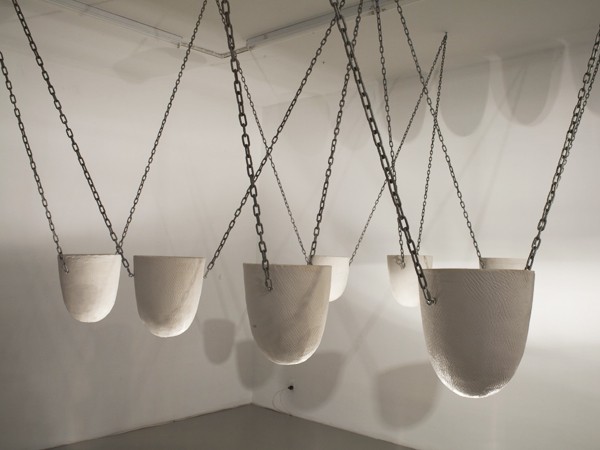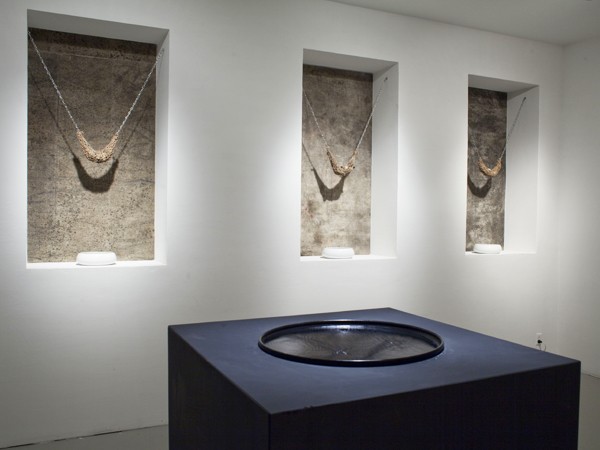Is it the case that people, places and things are only what we think of them? How can we put ourselves in the shoes of the Other? The artist Luis Armando García is interested in the role that tourism and criminality – as reductive as they are antithetical – have played in shaping the image of Mexico. In Viento del Norte, he sought to present another reality of his native country – far from stereotypes – that of ecology. However, it is not easy to abstract the violence that bears down so heavily on everyday life in the country. This violence poisons the climate, and is carried by the winds of the North. And so it was that, irrepressibly, dramatically, Viento del Norte changed shaped over time, and became Linea de Fuego.
García’s extended residency at LA CHAMBRE BLANCHE enabled him to explore his social, professional and personal identity from a range of viewpoints. It enabled him to understand, in new ways, the places from which people speak, and to reflect on the subjects of which people speak, and how they do so. As an interrogation on the nature of identity, appearances and communication, the substantial body of work that the artist produced during his stay expressed perfectly the fact that places, things and people are, to a significant extent, what we think of them, and what we make of them.
Viento del Norte was both a poetic and meditative installation that centered on the correspondence between the rigorous desert climate of the Zacatecas and that of the Quebec winter. Drought, as much as intense cold, influence social behavior and mood. Despite environmental differences, and differences in modes of adaptation linked to geography, in both cases tension plays a role in creating a form of anticipation and a particular means of naming meteorological phenomena such as rain and snow. A metaphor takes shape around this observation: that of the possibility to feel empathy for the Other based on one’s own experiences. This metaphor was translated with both sensitivity and efficiency in Viento del Norte by means of juxtaposing contrasts, albeit involving similar forms. Many visitors were amazed at how a Mexican, from a desert region, with no knowledge of snow, so clearly expressed the reality of the North, and furthermore with objects inspired by, or modeled after, forms used in arid areas to gather rainwater.
Such was García’s exploration. Beyond forms of prejudice that categorize people and destroy communication by affirming the differences between people and things, García seeks out that which is common. He identifies similarities, and based on these he extrapolates and constructs bridges that cross the divide between appearances and differences. This is no simple strategy, and it is one that has a precise effect. It endorses the artist’s discourse on the circulation and perception of identities, given that these are the very objects that he takes and re-stages in his creative process. The porous rocks that are used to filter and purify the all-too-rare water in the desert have featured in a previous group exhibition in 2002 in the town of Zacatecas. Once relocated to Quebec, they are replicated and molded, literally, on the local context. These water receptacles, chalk-white in color, cone-like in shape, whether in liquid or solid form, perfectly evoked both heat-waves and waves of cold. And so, that which travels, he who travels, is transformed, penetrating the universe of the Other, by means of his own experience. Given that we know both the heat and the cold, we can imagine the torrid and the polar. However, for those who have difficulty with one or the other, it becomes arduous to imagine living in such states on a daily basis. And for those who have never experienced frost, it is difficult to imagine that it can cause burns just as painful as those produced by fire.
The same can be said of violence. For those who have no real experience of such things, it is difficult to imagine the effect that it has on people. Imagining violence as a part of daily life is horrible for anyone who has experienced, even once, any kind of traumatic event. When the reality of the Other is too distant from one’s own, so there are obstacles to empathy, to the process of “approximation”, which gives way instead to indifference or contempt.
As a Mexican citizen, representing his country, Luis Armando García is situated at the point of convergence between attitudes that he indicates he often encounters amongst strangers. These fluctuate between a conventional exoticism, the denial of responsibility (faced with the humanitarian catastrophe and distress of the Other) and moral judgement. He finds that younger people are often more open to, and moved by, the political content of his work, perhaps because they are in a process of self-discovery, they are more open to the reality of others. The artist’s experience of the gaze and the perception of viewers is noticeable, and his concern regarding the judgement of the Other often surfaces. He mentioned on numerous occasions his pleasure at walking the streets of Quebec City, without the fear of being attacked, and without the burden of the perpetual tension that is, he explains, palpable throughout Mexico. When fellow Mexican performers arrived in the town and asked whether he had any recommendations of places to go, he suggested that they, “walk around the city and savor this unusual feeling of ease.” He insists that Mexicans are no more violent than the Quebecois. Rather, violence has taken hold insidiously over the years in the country, in connection with crime, and often linked with corruption. What can be done, faced with the spread of criminality, which now operates openly, including in his home town? Barricading oneself in, becoming a prisoner of one’s own fear, is hardly a solution. In succumbing too much to the mindset of protection, there is a loss of belief in the possibility of change. And so taking a position and acting has become a necessity for García, and this is a choice that he makes both in his personal and professional life.
This is why the white and fresh energy of Viento del Norte gave way to the heavy and threatening atmosphere of Linea de Fuego. Whilst the concept of the first installation was clear to the artist prior to coming to Quebec, the second installation, whilst present, lay more dormant as a concept within him. Linea de Fuego was grounded in the deterioration of the situation currently in Mexico and the grief of the recent death of a friend, a victim of assassination. Following the first few weeks of his residency, and the completion of Viento del Norte, García was faced with the proposition of unsettling things and stating, clearly and with urgency, that reality is something other than what lays before us; that life is more than appearances, and that just as poetry can be violent so violence can give rise to poetry. Moreover, poetry can be laden with tension.
The second work staged by Garcia dealt less with violence than its consequences, those of feeling trapped and powerless faced with the unknown. A number of elements, as coherent as they were troubling given their unfamiliarity, coalesced to create a no man’s land, where it seemed that anything could happen, for better or for worse. A sinister bunch of chains stood out immediately on entering the space. These were suspended from the ceiling and anchored to the floor, a hanging form that moved almost imperceptibly with the action of a motor. Visible through these iron tentacles, a web of electrical wires clung to the wall, with small bulbs hanging from their ends, like the synapses of the nervous system. Projectiles hung in front of them, in mid-air, like lead lines, sounding out obscure regions of the human. A lugubrious noise brought shudders: water in a pool bubbled as, on the surface, archival footage depicted the words of a hostage, who was soon to be assasinated. It is clear, without explaining each element, what the overall effect of the works suggested and demonstrated.
Beyond this, a noticeable feature of the work, for those who had witnessed Viento del Norte, was Garcia’s reuse of all the elements of the previous work. In a manner of speaking, the artist had dislocated, dismembered, kidnapped so to speak, the constituent parts, the witnesses of his first work, torturing and disposing of them in a completely different fashion to say something entirely new. A number of works, presented as paintings, bore the traces of their previous incarnation: plaster marks, rust stains that, along with the spectacular cone-like forms that now dripped rust-colored water along their once-immaculate form, spoke of bloodstains.
On a final note, it was astonishing to observe that fragments of fractured concrete paving stones in the space were hanging by a bare thread, which seemed mockingly, to symbolize the fight against the chaos all around. Yet, one must intervene, act and gather together the pieces of that which is broken. Such a gesture is not naive. It does not pretend to repair. It is a form of testimony. It is a matter of taking position and, faced with the undeniable difference of the Other, not succumbing to cynical fascination, to comfortable indifference, or to moral condemnation. This is important, because in the end people are to a significant extent what we think and what we make of them.



